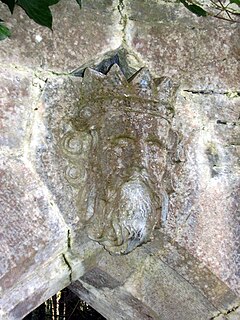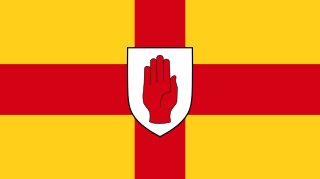| |||||
| Centuries: | |||||
|---|---|---|---|---|---|
| Decades: | |||||
| See also: | Other events of 1166 List of years in Ireland | ||||
Events from the year 1166 in Ireland.
| |||||
| Centuries: | |||||
|---|---|---|---|---|---|
| Decades: | |||||
| See also: | Other events of 1166 List of years in Ireland | ||||
Events from the year 1166 in Ireland.

The High Kings of Ireland were sometimes historical and sometimes legendary figures who had, or who are claimed to have had, lordship over the whole of Ireland for centuries.
Muircheartach Mac Lochlainn was king of Tír Eoghain, and High King of Ireland from around 1156 until his death in 1166. He succeeded Toirdhealbhach Ua Conchobhair who died in 1156.

Ruaidrí Ua Conchobair was King of Connacht from 1156 to 1186, and High King of Ireland from 1166 to 1193. He was the last High King of Ireland before the Norman invasion.

Ulster is a province in the north of the island of Ireland. It is made up of nine counties: six of these constitute Northern Ireland ; the remaining three are in the Republic of Ireland. It is the second largest and second most populous of Ireland's four provinces, with Belfast being its biggest city. Unlike the other provinces, Ulster has a high percentage of Protestants, making up almost half of its population. English is the main language and Ulster English the main dialect. A minority also speak Irish, and there are Gaeltacht in southern Londonderry, the Gaeltacht Quarter of Belfast and in Donegal, where 25% of the total Gaeltacht population of Ireland is located. Lough Neagh, in the east, is the largest lake in the British Isles, while Lough Erne in the west is one of its largest lake networks. The main mountain ranges are the Mournes, Sperrins, Croaghgorms and Derryveagh Mountains.
Diarmait Mac Murchada, anglicised as Dermot MacMurrough, Dermod MacMurrough, or Dermot MacMorrogh, was a King of Leinster in Ireland. In 1167, he was deprived of his kingdom by the High King of Ireland – Ruaidri Ua Conchobair. The grounds for the dispossession were that Mac Murchada had, in 1152, abducted Derbforgaill, the wife of the King of Breifne, Tiernan O'Rourke. To recover his kingdom, Mac Murchada solicited help from the King of England Henry II of England. His issue unresolved, he gained the military support of the Earl Richard de Clare, the 2nd Earl of Pembroke, who was in opposition to Henry II due to his support for Stephen, King of England against Henry's mother in The Anarchy. In exchange for his aid, Strongbow was married to Mac Murchada's daughter Aoife and promised succession to the Kingship of Leinster. Henry II then mounted a larger second invasion in 1171 to ensure his control over Strongbow, resulting in the Norman Lordship of Ireland. Mac Murchada was later known as Diarmait na nGall.
Tighearnán Mór Ua Ruairc, anglicised as Tiernan O'Rourke ruled the Kingdom of Bréifne as the 19th king in its Ua Ruairc dynasty, a branch of the Uí Briúin. He was a descendant of Ui Riagain, and one of the provincial kings in Ireland in the twelfth century, constantly expanding his kingdom through shifting alliances, of which the most long-standing was with Toirdelbach Ua Conchobair King of Connacht and High King of Ireland, and subsequently his son and successor Ruaidhri Ua Conchobair. He is known for his role in the expulsion of Diarmait Mac Murchada, King of Leinster, from Ireland in 1166. Mac Murchada's subsequent recruitment of Marcher Lords to assist him in the recovery of his Kingdom of Leinster ultimately led to the Norman invasion of Ireland.
Conchobar Maenmaige Ua Conchobair, son of High King of Ireland Ruaidrí Ua Conchobair, was King of Connacht from 1183 to 1189. He was a military commander and opponent of the Norman invasion of Ireland.
Toirdhealbhach Ua Conchobhair anglicised Turlough Mór O'Connor / O'Conor, was King of Connacht (1106–1156) and High King of Ireland.

Domhnall Ua Lochlainn, also known as Domhnall Mac Lochlainn, claimed to be High King of Ireland.
Toirdhealbhach Ua Briain, anglicised Turlough O'Brien, was King of Munster and effectively High King of Ireland. A grandson of Brian Bóruma, Toirdelbach was the son of Tadc mac Briain who was killed in 1023 by his half-brother Donnchad mac Briain.
Muircheartach Ua Briain, son of Toirdelbach Ua Briain and great-grandson of Brian Bóruma, was King of Munster and later self-declared High King of Ireland.
The Battle of Móin Mhór was fought in 1151 between the kingdoms of Leinster and Thomond in Ireland. The Kingdom of Leinster was victorious.
Events from the year 1156 in Ireland.
Events from the year 1177 in Ireland.
Ruaidrí ua Canannáin was king of the Cenél Conaill, and according to some sources, High King of Ireland.
Flaithbertach Ua Néill was king of Ailech, a kingdom of north-west Ireland. He abdicated in 1030 and undertook a pilgrimage to Rome, for which reason he was known as Flaithbertach an Trostáin. Following the death of his son Áed in 1033, Flaithbertach left his retirement and resumed the leadership of the Northern Uí Néill.
Ruaidrí Ua Conchobair, called Ruaidrí na Saide Buide was King of Connacht, perhaps twice.
Domnall mac Ruaidrí Ua Conchobair (1102–1106) was King of Connacht.
Muirchertach Tethbhach Ua Conchobair, Prince of Connacht, died 1204.
Áed in Macáem Tóinlesc or Aodh an Macaoimh Tóinleasg was a 12th-century ruler of Tulach Óc and Tír Eogain. He was the first of his family to play a significant role in the high politics of northern Ireland, following the death of the Muirchertach Mac Lochlainn king of Tír Eogain and high king of Ireland.
Events from the year 1102 in Ireland.
Events from the year 1167 in Ireland.
Niall Mac Lochlainn was a Cenél nEógain king of the Northern Ui Neill. He was a member of the Meic Lochlainn, and a son of Muirchertach Mac Lochlainn, King of Cenél nEógain. Ruaidrí Ua Conchobair, King of Connacht divided Tír nEógain between Niall and Áed Méith Ua Néill. Muirchertach's granddaughter, Findguala, who married Guðrøðr Óláfsson, King of Dublin and the Isles, appears to have been a daughter of Niall.

Mac Scelling, also known as Mac Scilling, was a prominent twelfth-century military commander engaged in conflicts throughout Ireland. He is first recorded in 1154 commanding the maritime forces of Muirchertach Mac Lochlainn, King of Cenél nEógain in a bloody encounter against Toirrdelbach Ua Conchobair, King of Connacht. Muirchertach's naval forces were drawn from the western peripheries of Scotland and the Isles. He next appears on record in 1173/1174, supporting the cause of Ruaidrí Ua Conchobair, King of Connacht against the English colonisation of Mide. An early modern Scottish source claims that a man of the same name was a bastard son of Somairle mac Gilla Brigte, King of the Isles. If Mac Scelling was indeed related to Somairle, this relationship could cast light on the latter's conflict with Guðrøðr Óláfsson, King of the Isles, a man who appears to have opposed Muirchertach at some point in his career. Although not termed so in contemporary sources, Mac Scelling may be regarded as an early archetype of later gallowglasses, heavily-armed Scottish mercenaries recruited by Irish rulers in centuries that followed.